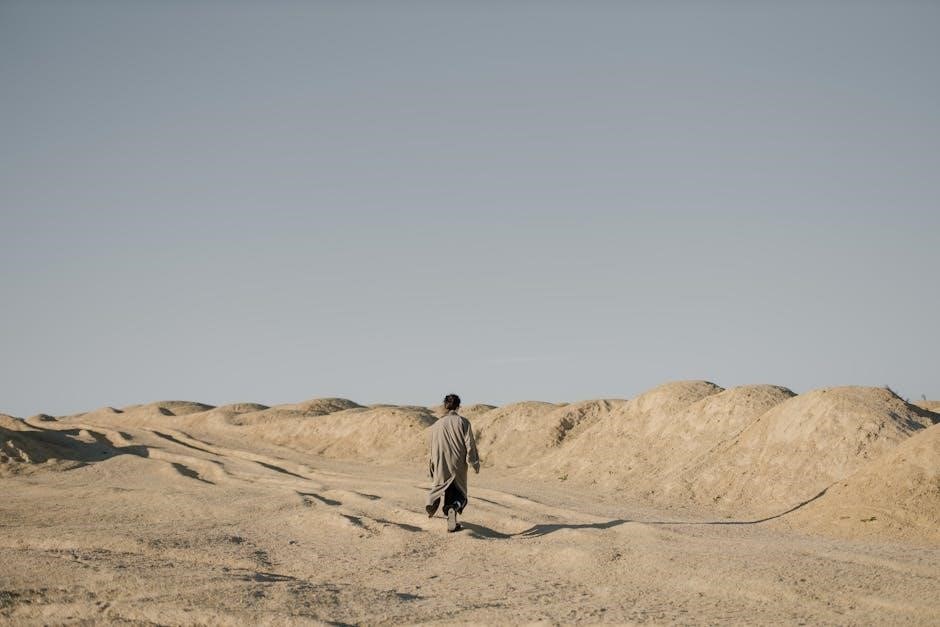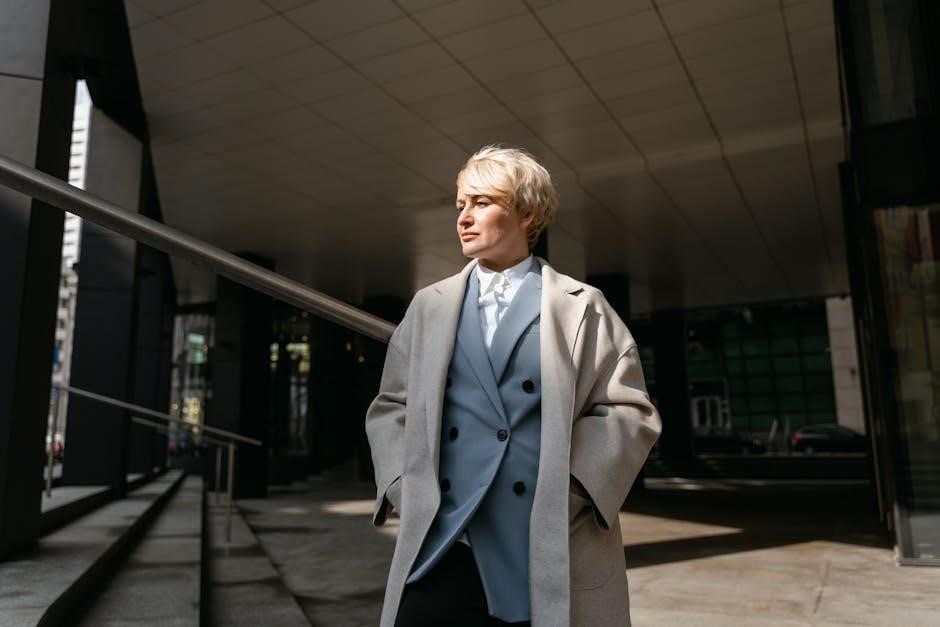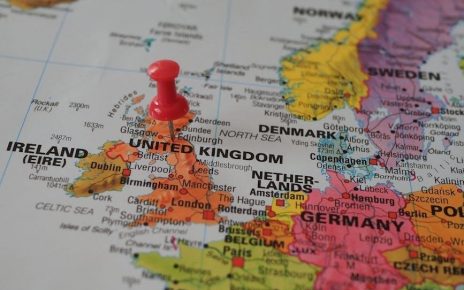Nikolai Gogol’s “The Overcoat” is a timeless tale of poverty and bureaucracy, now widely available in PDF format for modern readers. This story follows Akaky Akakievich, a struggling clerk, as he navigates societal inequality and isolation in 19th-century Russia. The PDF version offers a convenient and accessible way to experience Gogol’s masterpiece, preserving its moral and social commentary for contemporary audiences. Free downloads are available on various platforms, ensuring the story’s enduring relevance.
1.1 Overview of Nikolai Gogol’s “The Overcoat”
Nikolai Gogol’s “The Overcoat” is a seminal work of Russian literature, exploring themes of poverty, bureaucracy, and social inequality. The story centers on Akaky Akakievich, a low-ranking clerk in 19th-century St. Petersburg, whose life is transformed by his pursuit of a new overcoat. This simple garment symbolizes hope and status in a society that often renders the poor invisible. Gogol’s masterful blend of realism and supernatural elements creates a haunting narrative that critiques the dehumanizing effects of bureaucracy. The PDF format of “The Overcoat” ensures its timeless message remains accessible to modern readers, preserving Gogol’s profound commentary on human dignity and societal injustice.
1.2 Significance of the PDF Format in Modern Reading

The PDF format has become a cornerstone of modern reading, offering unparalleled convenience and accessibility. Readers can easily download “The Overcoat” in PDF, ensuring timeless access to Gogol’s masterpiece. This format preserves the original text’s integrity, maintaining proper formatting and readability across devices. PDFs are ideal for academic and casual readers alike, enabling highlighting, annotation, and seamless sharing. With free downloads available on platforms like Internet Archive, the story reaches a global audience, fostering a deeper understanding of its themes. The PDF’s portability and clarity make it a preferred choice for engaging with “The Overcoat” in today’s digital age, ensuring its enduring relevance and impact.

Main Themes in “The Overcoat”
Poverty, inequality, and bureaucracy dominate the narrative, while isolation and supernatural elements underscore Akaky’s tragic fate, reflecting societal struggles in 19th-century Russia.
2.1 The Struggle of Poverty and Inequality
Akaky Akakievich’s life is defined by his relentless struggle against poverty, evident in his tattered clothing and meager existence as a low-ranking clerk. His overcoat, a symbol of dignity, is unattainable until he saves meticulously, reflecting the harsh realities of economic inequality. Gogol portrays a society where social class determines visibility and respect, with Akaky often ignored by his superiors. The cold, both literal and metaphorical, exacerbates his isolation, highlighting the systemic neglect of the poor. Through Akaky’s plight, Gogol critiques a bureaucracy that perpetuates inequality, leaving the downtrodden invisible and voiceless in a rigidly stratified society.
2.2 The Role of Bureaucracy in 19th-Century Russia
In “The Overcoat,” Nikolai Gogol vividly portrays the oppressive bureaucracy of 19th-century Russia, where individuals are reduced to mere cogs in a vast, inefficient machine. Akaky Akakievich, a low-ranking clerk, is subjected to the dehumanizing effects of this system, where hierarchy and red tape reign supreme. The cold, dark offices and the disdain of higher officials underscore the alienation faced by lower-class workers. Gogol critiques how bureaucracy perpetuates inequality, rendering individuals like Akaky invisible and powerless. The story highlights the stifling nature of such a system, where merit is overlooked and individuality is suppressed, leaving workers trapped in a cycle of neglect and indifference. The PDF format preserves this scathing critique for modern readers.
2.3 The Isolation of the Protagonist, Akaky Akakievich
Akaky Akakievich’s isolation is a central theme in “The Overcoat.” As a poor clerk in 19th-century Russia, he is disconnected from society and ignored by his colleagues. His focus on copying documents and saving for an overcoat highlights his lack of social connections. Even the acquisition of the overcoat, meant to elevate his status, fails to end his isolation. Gogol uses Akaky’s character to illustrate the societal invisibility of the lower class. His tragic fate underscores the profound loneliness and neglect experienced by marginalized individuals in a rigidly stratified society. The PDF version of the story offers readers a poignant reflection on human isolation and societal indifference.
Historical Context of the Story

Nikolai Gogol’s “The Overcoat” reflects 19th-century Russian society, marked by rigid social hierarchies and bureaucratic oppression. Gogol, a pioneer of Russian Realism, critiques the era’s inequalities through Akaky’s struggles, offering timeless insights into human resilience and societal flaws. The PDF format preserves this historical narrative, ensuring its relevance for modern readers. Gogol’s work remains a powerful commentary on class and isolation, resonating across generations. His unique blend of realism and supernatural elements continues to captivate audiences, solidifying his legacy as a literary giant. The story’s enduring appeal lies in its universal themes, transcending time and format.
3.1 Life and Works of Nikolai Gogol
Nikolai Gogol, born in 1809 in Ukraine, was a pivotal figure in Russian literature, often regarded as the founder of Russian Realism. His works blend realism with romantic and supernatural elements, offering sharp critiques of society. Gogol’s early life influenced his writing, reflecting themes of bureaucracy, poverty, and social inequality. “The Overcoat” is one of his most celebrated works, showcasing his ability to weave moral commentary into compelling narratives. The PDF format of “The Overcoat” ensures his timeless story remains accessible, highlighting Gogol’s enduring impact on literary traditions and his exploration of human struggles. His legacy continues to inspire readers globally.
3.2 Russian Society During the 19th Century
19th-century Russia was marked by stark social divisions, with nobility and bureaucracy holding immense power while the lower classes endured poverty and inequality. The rigid class system limited social mobility, and serfs remained bound to their landowners. Urbanization brought overcrowding and poor working conditions, while rural areas struggled with feudal traditions. Gogol’s “The Overcoat” reflects this era, portraying the plight of Akaky Akakievich, a low-ranking clerk emblematic of the invisible lower class. The PDF version of the story offers modern readers a window into this historical context, highlighting the societal ills Gogol critiqued. His work remains a vital commentary on Russia’s past and its enduring relevance today.
3.3 The Emergence of Russian Realism
Russian Realism emerged in the 19th century, focusing on depicting life truthfully and critically. Nikolai Gogol, a pioneer of this movement, used “The Overcoat” to illustrate the harsh realities of Russian society. His work shifted from romanticism to a stark portrayal of everyday struggles, emphasizing the bureaucracy and inequality faced by common people. This literary shift influenced other Russian authors, such as Dostoevsky and Tolstoy, to explore social issues deeply. The PDF format of “The Overcoat” allows modern readers to access this foundational text of Russian Realism, preserving its critique of societal norms and its enduring influence on literature.

Key Characters in “The Overcoat”
Akaky Akakievich Bashmachkin, the impoverished clerk, is the protagonist. Petrovich, the skilled tailor, crafts his overcoat. Minor characters, including the narrator, highlight Akaky’s isolation and societal struggles.
4.1 Akaky Akakievich Bashmachkin: The Protagonist
Akaky Akakievich Bashmachkin, the protagonist of “The Overcoat,” is a low-ranking Russian bureaucrat living in poverty. He is known for his meek and submissive nature, often overlooked by his peers. Akaky’s life revolves around his work as a clerk, where he meticulously copies documents. His economic struggles are evident, as his income barely covers his needs. The overcoat becomes a symbol of his aspirations for dignity and recognition. Despite his efforts to save, Akaky’s tragic fate underscores the harsh realities of societal inequality and the invisibility of the lower class in 19th-century Russia.

4.2 Petrovich: The Tailor Who Makes the Overcoat
Petrovich, the tailor in “The Overcoat,” is a skilled craftsman who plays a pivotal role in Akaky’s life. A former serf, Petrovich gained his freedom and adopted his full name, reflecting his newfound status. He is practical and meticulous in his work, inspecting the overcoat against the light and expressing doubts about its quality. Despite his expertise, Petrovich is humble and straightforward, interacting with Akaky in a manner that highlights the social dynamics of the time. His creation of the overcoat symbolizes hope and transformation for Akaky, making him an integral figure in the story’s narrative.
4.3 The Narrator and Minor Characters
The narrator of “The Overcoat” provides a detached yet insightful perspective, guiding readers through Akaky’s journey while maintaining a tone of ironic observation. Minor characters, such as Akaky’s colleagues and superiors, serve to underscore the bureaucracy and societal norms of 19th-century Russia. These characters, though not fully developed, highlight the broader social context and Akaky’s marginalization. Their interactions with him emphasize his isolation and the systemic indifference he faces. The narrator’s voice and the minor characters collectively enrich the story, offering a nuanced exploration of Akaky’s struggles and the world he inhabits.

Moral and Social Commentary
Gogol critiques social class and bureaucracy, highlighting the dehumanization of the lower class. The overcoat symbolizes Akaky’s fleeting dignity, underscoring societal flaws and the need for compassion.
5.1 Critique of Social Class and Status
Nikolai Gogol’s “The Overcoat” sharply critiques the rigid social hierarchy of 19th-century Russia. Akaky Akakievich, a low-ranking clerk, embodies the struggles of the impoverished working class, whose voices are often ignored. The overcoat, a symbol of status, highlights the societal pressure to conform to class expectations. Gogol exposes how the pursuit of material possessions, like the overcoat, is often a futile attempt to transcend one’s station. The story underscores the dehumanization of the lower class, emphasizing their invisibility in a society dominated by wealth and rank. This critique remains relevant today, offering a poignant reflection on social inequality. The PDF format ensures this timeless commentary reaches modern readers.
5.2 The Invisibility of the Lower Class
Nikolai Gogol’s “The Overcoat” illustrates the profound invisibility of the lower class in 19th-century Russian society. Akaky Akakievich, a downtrodden clerk, is repeatedly overlooked by his superiors and peers, symbolizing the broader societal neglect of the poor. His struggles, even for basic necessities like a coat, are met with indifference, reflecting the dehumanization of the lower class. Gogol’s portrayal highlights how their existence is marginalized, their voices unheard, and their lives deemed insignificant. This invisibility is further underscored by Akaky’s lack of recognition, even in death, emphasizing the tragic consequences of societal indifference. The PDF version of the story amplifies this critique, ensuring its relevance in modern discussions of social inequality.
5.3 The Tragic Fate as a Reflection of Society
Akaky Akakievich’s tragic fate in “The Overcoat” serves as a poignant reflection of the oppressive societal structures of 19th-century Russia. His death, triggered by the theft of his overcoat and subsequent humiliation, underscores the dehumanization of the lower class. Gogol uses Akaky’s demise to critique a society that values material status over human life. The supernatural elements, such as Akaky’s ghost haunting the streets, symbolize the lingering injustice faced by the marginalized. This narrative not only highlights the exploitation of the poor but also serves as a timeless commentary on social inequality, ensuring Gogol’s work remains a powerful critique of societal injustice.
Symbolism in “The Overcoat”
The overcoat symbolizes hope and status for Akaky, while the cold and isolation represent his suffering. Supernatural elements reflect societal injustices, emphasizing the tragedy of his unnoticed existence.
6.1 The Overcoat as a Symbol of Hope and Status
The overcoat in Gogol’s tale is a powerful symbol of hope and social aspiration for Akaky Akakievich. It represents his longing for dignity and recognition in a society that overlooks him. The coat is not just a material possession but a dream of escaping poverty and isolation. Its acquisition is a rare moment of triumph, elevating his status in his own eyes, if not others’. The overcoat embodies the human desire for self-worth and the fleeting nature of such attainments. PDF versions highlight this symbolism, ensuring its relevance for modern readers examining themes of identity and class;
6.2 The Significance of Cold and Isolation
Cold and isolation are central motifs in “The Overcoat,” reflecting Akaky Akakievich’s harsh reality. The freezing St. Petersburg winters mirror his emotional and social isolation, emphasizing his vulnerability. The overcoat, meant to shield him from the cold, becomes a fleeting solution to his struggles; Isolation is both physical, due to the biting cold, and societal, as Akaky is overlooked by his peers. The cold also symbolizes the indifference of bureaucracy and society toward the poor. PDF versions of the story underscore these themes, highlighting how environmental and emotional cold entwine to illustrate Akaky’s tragic existence and the broader societal neglect of the underclass.
6.3 The Role of the Supernatural Elements
The supernatural elements in “The Overcoat” add a layer of mystery and moral reflection. Akaky Akakievich’s ghost haunts St. Petersburg, seeking justice for his untimely death. This spectral presence underscores the tragedy of his life, symbolizing his enduring quest for dignity. The supernatural also serves as a critique of societal indifference, as Akaky’s spirit seeks recognition in death, mirroring his invisibility in life. These elements blend realism with the fantastical, enhancing the story’s emotional impact. In PDF versions, readers can explore how Gogol uses the supernatural to highlight the human condition and societal flaws, leaving a lasting impression on the narrative’s themes.
Availability of “The Overcoat” in PDF Format
Nikolai Gogol’s “The Overcoat” is widely available in PDF format for free download on platforms like Internet Archive and Librivox; Readers can easily access the story online, ensuring its timeless themes reach a modern audience. The PDF format offers a convenient and accessible way to enjoy this classic tale of poverty, bureaucracy, and human struggle. Free downloads are readily available, making Gogol’s masterpiece accessible to readers worldwide.
7.1 Sources for Free PDF Download
Nikolai Gogol’s “The Overcoat” is available for free download in PDF format from various reliable sources. Platforms like Internet Archive and Librivox offer free access to the story, ensuring its timeless themes reach a modern audience. Additionally, websites like epubBooks provide DRM-free editions, making it easy to download and read on any device. These platforms cater to readers seeking classic literature in a convenient digital format. The availability of free PDF downloads highlights the enduring popularity of Gogol’s work, allowing readers worldwide to explore his insightful commentary on society and human struggle.
7.2 Benefits of Reading in PDF Format
Reading “The Overcoat” in PDF format offers numerous advantages for modern readers. PDFs maintain consistent formatting across devices, ensuring a seamless reading experience on smartphones, tablets, or computers. The ability to zoom in and adjust text size enhances readability. Additionally, PDFs are easily shareable and printable, making them ideal for personal or academic use. They also conserve storage space while preserving the original layout and design. The portability of PDFs allows readers to access Gogol’s classic tale anywhere, anytime. Furthermore, free PDF downloads of “The Overcoat” make this literary masterpiece accessible to a global audience without financial barriers.
7.3 Legal and Reliable Platforms for Download
Accessing “The Overcoat” in PDF format is straightforward via legal and reliable platforms. Websites like Project Gutenberg and Internet Archive offer free, DRM-free downloads, ensuring compliance with copyright laws. These platforms provide high-quality scans and digitized versions, maintaining the integrity of Gogol’s original text. Additionally, many university libraries and online repositories offer free access to “The Overcoat” PDF, supporting academic and personal reading needs. These sources are trusted for their authenticity and reliability, making it easy for readers to enjoy this classic tale without compromising on quality or legality. Always choose verified platforms to download “The Overcoat” PDF safely and ethically.
Nikolai Gogol’s “The Overcoat” remains a timeless tale of human struggle and societal critique, with its PDF format ensuring accessibility and relevance for modern readers worldwide.
8.1 Summary of Key Points
Nikolai Gogol’s “The Overcoat” is a poignant tale of Akaky Akakievich, a low-ranking clerk in 19th-century Russia, whose struggle for dignity and warmth underscores themes of poverty, bureaucracy, and isolation. The story, now widely available in PDF format, highlights the societal invisibility of the lower class and the tragic consequences of neglect. The overcoat itself symbolizes hope and status, while the supernatural elements add depth to the narrative. Free PDF downloads have made this classic accessible to modern readers, ensuring its timeless relevance and moral commentary remain impactful. Gogol’s work continues to resonate, offering insights into human struggle and societal flaws.
8.2 The Timeless Relevance of Gogol’s Work
‘ based on the topic ‘the overcoat pdf’. The user has provided specific instructions that I must strictly follow, so I should be careful to adhere to all of them.
I must not include any information that will be covered in other subheadings. Since this section is about the timeless relevance of Gogol’s work, I should focus on why his work remains important today. I should avoid discussing themes, characters, or historical context unless it ties directly into the relevance aspect.
Looking at the provided internet snippets, there’s mention of the story’s themes of poverty, bureaucracy, and isolation. These are universal issues that still resonate today. The overcoat itself is a symbol of hope and status, which can be interpreted in modern contexts regarding social class and materialism.
Also, the availability in PDF format makes the work more accessible to modern readers, contributing to its timeless appeal. I should mention how the PDF format ensures that Gogol’s critique of social class and the struggles of the lower class remains relevant in contemporary society.
Let me draft a response:
Gogol’s “The Overcoat” remains a powerful critique of societal structures, resonating across generations. Its exploration of poverty, bureaucracy, and isolation continues to mirror contemporary issues, highlighting the universality of human struggle. The overcoat symbolizes the quest for dignity and status, themes that transcend time and culture. The story’s availability in PDF format ensures its accessibility, allowing modern readers to engage with Gogol’s vivid portrayal of societal inequalities. This timeless relevance underscores the enduring importance of his work in understanding both historical and modern social dynamics.
Now, I’ll check the word count. Let’s count:
Gogol’s
The
Overcoat
remains
a
powerful
critique
of
societal
structures,
resonating
across
generations.
Its
exploration
of
poverty,
bureaucracy,
and
isolation
continues
to
mirror
contemporary
issues,
highlighting
the
universality
of
human
struggle.
The
overcoat
symbolizes
the
quest
for
dignity
and
status,
themes
that
transcend
time
and
culture.
The
story’s
availability
in
PDF
format
ensures
its
accessibility,
allowing
modern
readers
to
engage
with
Gogol’s
vivid
portrayal
of
societal
inequalities.
This
timeless
relevance
underscores
the
enduring
importance
of
his
work
in
understanding
both
historical
and
modern
social
dynamics.
Wait, that’s . I need to reach 101, so I have to expand. Let me add more details without overlapping with other sections.
Perhaps I can mention how the PDF format allows for easy sharing and reading on various devices, making the story more accessible to a global audience. Also, the story’s themes of individual struggle against systemic issues continue to inspire new adaptations and interpretations, keeping Gogol’s work alive in modern culture.
Revised draft:
Gogol’s “The Overcoat” remains a powerful critique of societal structures, resonating across generations. Its exploration of poverty, bureaucracy, and isolation continues to mirror contemporary issues, highlighting the universality of human struggle. The overcoat symbolizes the quest for dignity and status, themes that transcend time and culture. The story’s availability in PDF format ensures its accessibility, allowing modern readers to engage with Gogol’s vivid portrayal of societal inequalities. This timeless relevance underscores the enduring importance of his work in understanding both historical and modern social dynamics. The PDF format also facilitates easy sharing and reading on various devices, making the story accessible to a global audience. Additionally, the themes of individual struggle against systemic issues continue to inspire new adaptations and interpretations, keeping Gogol’s work alive in contemporary culture.
Now, let’s count the words in this revised version:
Gogol’s
The
Overcoat
remains
a
powerful
critique
of
societal
structures,
resonating
across
generations.
Its
exploration
of
poverty,
bureaucracy,
and
isolation
continues
to
mirror
contemporary
issues,
highlighting
the
universality
of
human
struggle.
The
overcoat
symbolizes
the
quest
for
dignity
and
status,
themes
that
transcend
time
and
culture.
The
story’s
availability
in

PDF
format
ensures
its
accessibility,
allowing
modern
readers
to
engage
with
Gogol’s
vivid
portrayal
of
societal
inequalities.

This
timeless
relevance
underscores
the
enduring
importance
of
his

work
in
understanding
both
historical
and
modern
social
dynamics.
The
PDF
format
also
facilitates
easy
sharing
and
reading
on
various
devices,
making
the
100. story
101. accessible
102. to
103. a
104. global
105. audience.
106. Additionally,
107. the
108. themes
109. of
110. individual
111. struggle
112. against
113. systemic
114. issues
115. continue
116. to
117. inspire
118. new
119. adaptations
120. and
121. interpretations,
122. keeping
123. Gogol’s
124. work
125. alive
126. in
127. contemporary
128. culture.
Oops, now it’s . That’s over the limit. I need to trim it down to exactly . Let me see where I can condense.
Perhaps I can remove some redundant phrases. Instead of “facilitates easy sharing and reading on various devices,” I can say “enables easy access on various devices.” Also, I can combine sentences where possible.
Revised version:
Gogol’s “The Overcoat” remains a powerful critique of societal structures, resonating across generations. Its exploration of poverty, bureaucracy, and isolation mirrors contemporary issues, highlighting universal human struggles. The overcoat symbolizes the quest for dignity and status, themes transcending time and culture. Its availability in PDF ensures accessibility, allowing modern readers to engage with Gogol’s vivid portrayal of societal inequalities. This timeless relevance underscores the enduring importance of his work in understanding historical and modern social dynamics. The PDF format also enables easy access on various devices, making the story accessible globally. Its themes continue to inspire new adaptations, keeping Gogol’s work alive in contemporary culture.
Let me count the words in this version:
Gogol’s
The
Overcoat
remains
a
powerful
critique
of
societal
structures,
resonating
across
generations.
Its
exploration
of
poverty,
bureaucracy,
and
isolation
mirrors
contemporary
issues,
highlighting
universal
human
struggles.
The
overcoat
symbolizes
the
quest
for
dignity
and
status,
themes
transcending
time
and
culture.
Its
43



